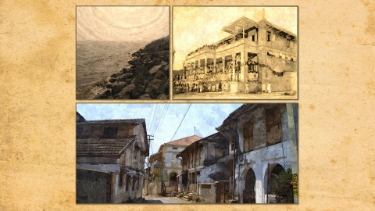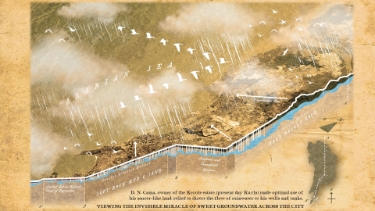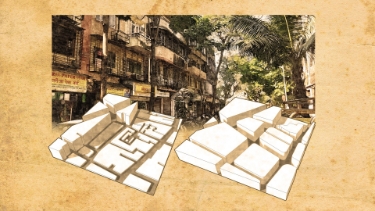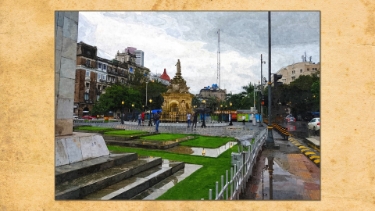GALLERY 02 | WATER & CULTURE
EXHIBIT 03/03 03
Water and Communities
Explore the sub exhibits
Zoroastrianism originated in the year 1500 B.C.E. and is recognized as the oldest, revealed, henotheist religion of the world. Zoroastrians believe in the preservation and promotion of the seven creations of Ahura Mazda, their principal divinity.
Having found peace and sanctuary in India after fleeing persecution and genocide in their ancient Iranian homeland, this short story from the lens of a young, local Zoroastrian captures the journey and impact this treasured community has had on the multi-culturalist water heritage of Greater Mumbai.
ख्रिस्त पुर्व १५०० वर्षांपूर्वी झोरॅष्ट्रियन (पारशी) धर्माची स्थापना झाली आणि आज देखील तो जगातील सर्वांत जुना, प्राचीन काळापासून अस्तित्वात असलेला व एकच इष्ट देवतेला पुजणारा धर्म म्हणून ओळखला जातो. ‘आहुरा माझदा’, त्यांचे सर्वश्रेष्ठ दैवत, यांनी निर्माण केलेल्या सात गोष्टींचे जतन करणे आणि त्या वृद्धिंगत करणे हे पारशी समाज स्वतःचे कर्तव्य मानतो. या सात निर्मितीतील दुसरी निर्मिती मानले गेलेल्या पाण्याचा, नीतिमान, प्रामाणिक झोराष्ट्रीयन समाजाच्या जीवनाशी खूप जवळचा संबंध आहे.
छळ आणि नरसंहारापासून स्वतःचे रक्षण करण्यासाठी प्राचीन ईराणी जन्मभूमीतून विस्थापित झालेल्या, शांतता आणि आश्रय मिळविण्यासाठी भारतात आलेल्या पारशी समाजाचा आत्तापर्यंतचा प्रवास आणि मुंबईच्या बहुरंगी सांस्कृतिवर त्यांचा प्रभाव याचा आढावा घेण्याचा रंजक प्रयत्न या शहरातीलच एक पारशी तरुणाने या लघुकथेद्वारे केला आहे.
































FROM THE SEAS TO THE WELLS AND BEYOND
A PARSI’S WATER TALE
ERVAD BERJIS DRIVER
અત હિશ અવી ફર્ટાચેતિ * યાટ હિશ અવી ફ્રઝગરાઈટી * અરેડવી સુરા અનાહિતા
Yat hish avi fratachaiti Yat hish avi frazgaraiti Aredvi Sura Anahita
To whatever parts the undefiled Ardvi Sura (River) flows, she renders
those parts prosperous.
I am a young Zoroastrian priest, belonging to the twenty-third generation of a family which originated from the
migrant, Kaka Pahlun.
He fled his Iranian homeland during the Arabian conquests, braved the perilous storms at sea and finally arrived on the shores of India as part of an
exodus in the year 936 A.C.

My elders tell me of the ‘first teacher’ Spitama Zarathustra, who through his
READ MORE


Under Ahura Mazda, a host of Bounteous Immortals: the ‘Amesha Spentas’ and
READ MORE


We were close to the seas in Gujarat during our initial period of settling in
READ MORE


As Bombay kept growing, more and more Zoroastrians continued migrating from
READ MORE


Kuas (wells) are essential for the consecration of fire temples. In this regard,
READ MORE


As my community accords water with deep respect and treats it as a living entity, we
READ MORE


The coming of dawn is observed as a triumph of good over evil.
READ MORE


Alongside the Panpois, Tanks and Pyaavs, the Zoroastrian Kuas on repeated
READ MORE


Zoroastrian estate owners and philanthropists like F. Cowasjee, J.
READ MORE


Given the progressive degree of development Mumbai has witnessed, I
READ MORE


This 19th century wadi has since undergone a massive transformation and
READ MORE


However, the transitions of the built environment, coming of pipes, the plague
READ MORE


From the tanks to the kuas, the fountains and the pyaavs, the generations of
READ MORE


Parsi: Thy Name Will Eternally Remain (Water) Charity
